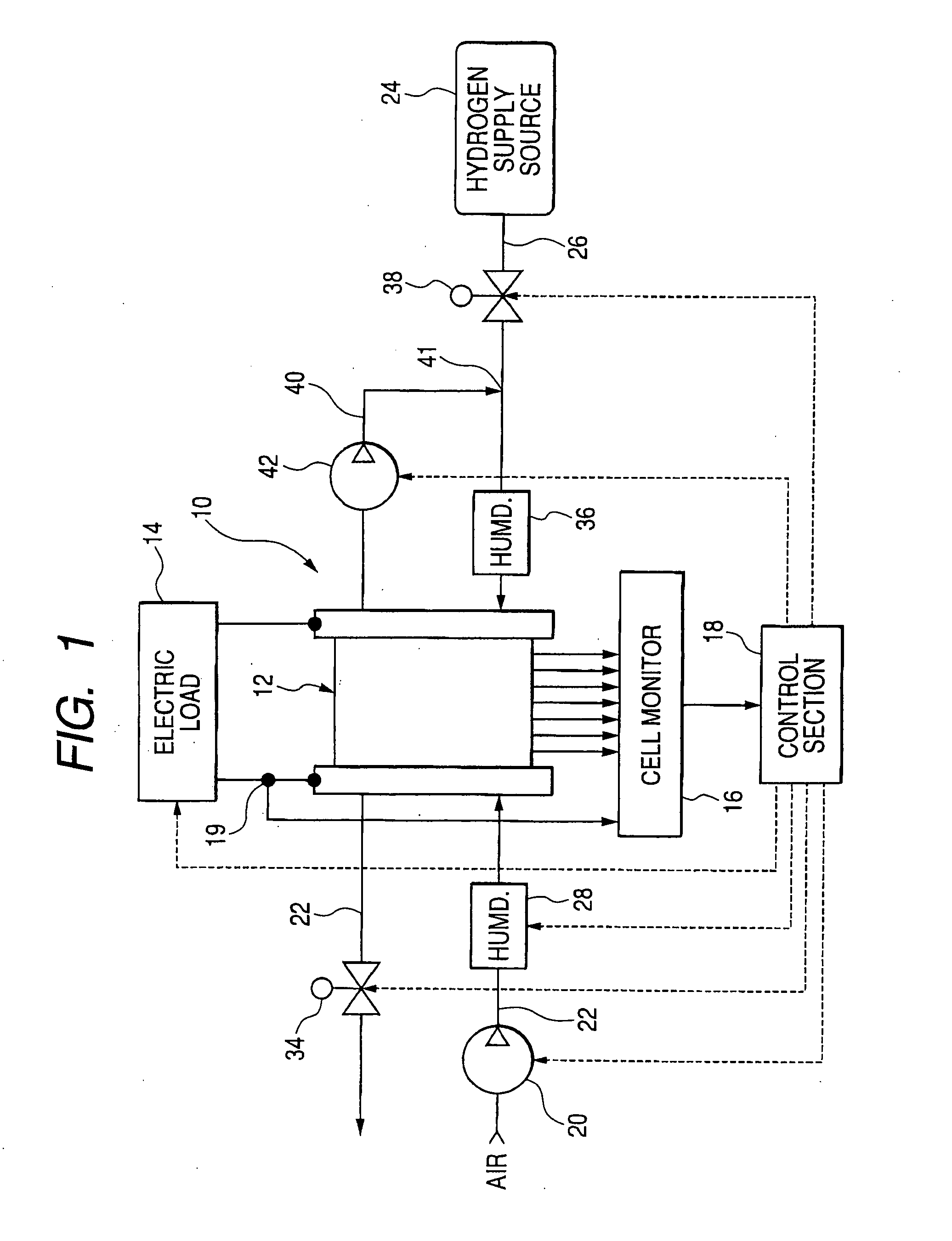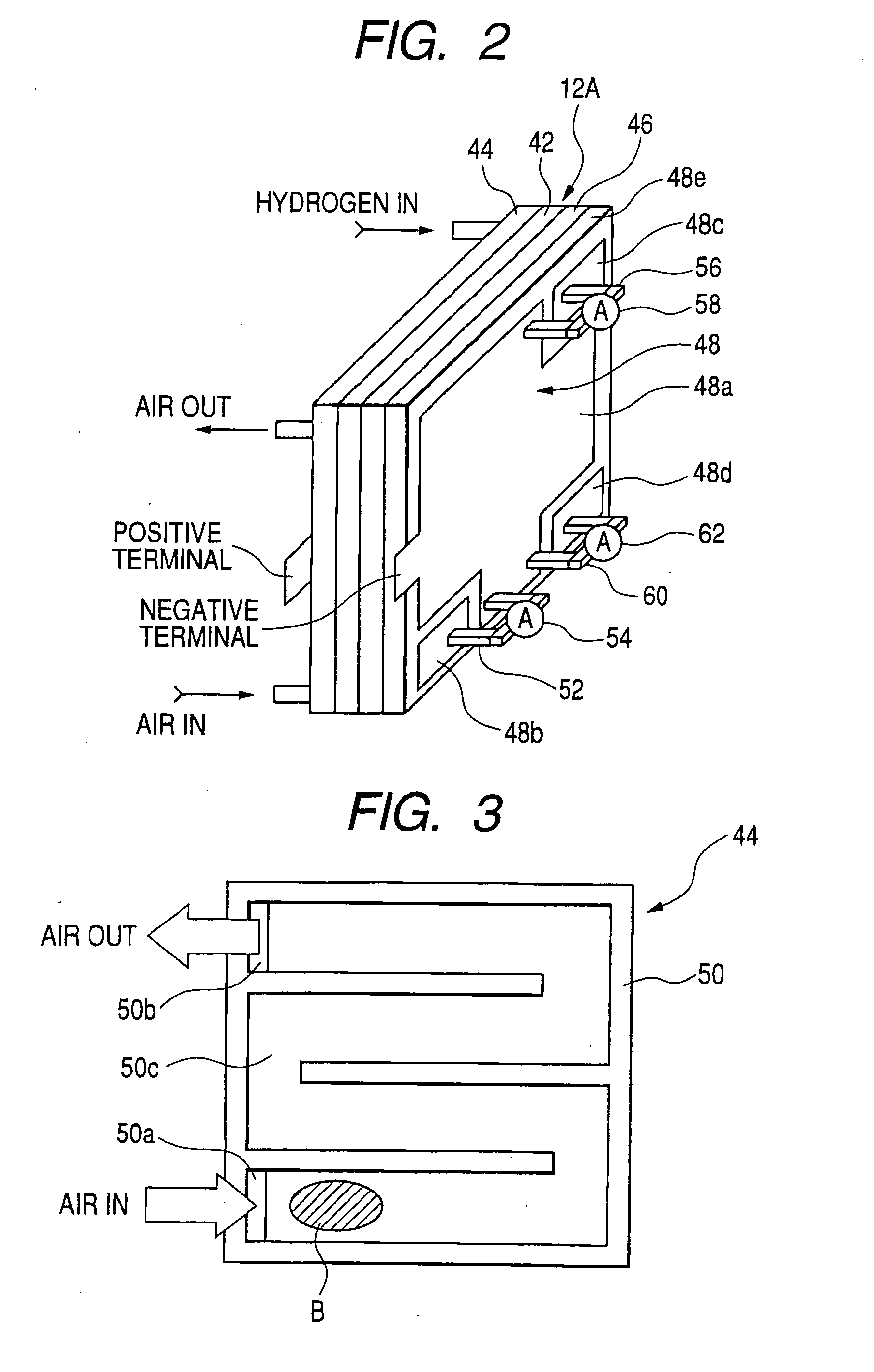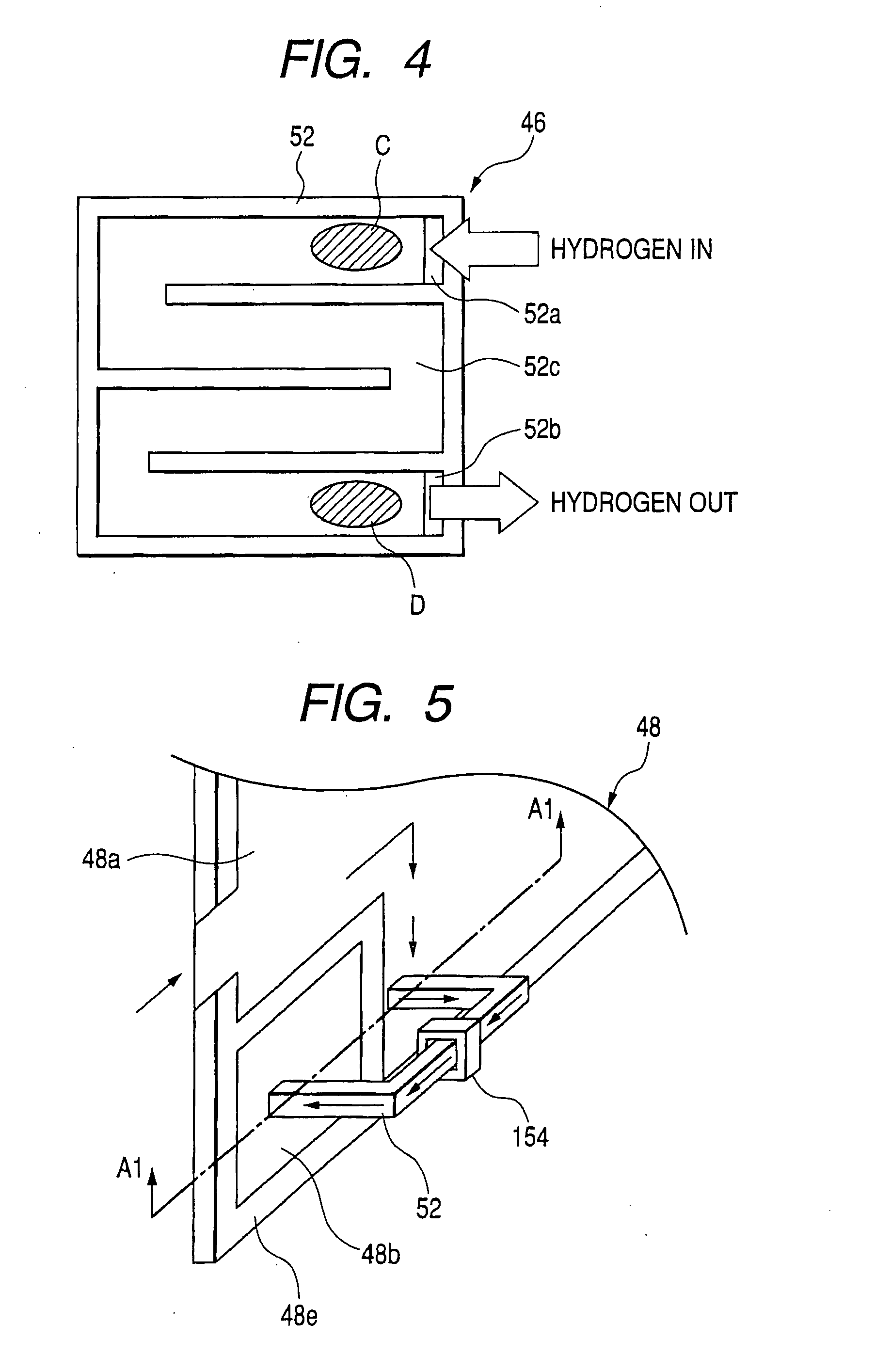In the state of the art fuel cell systems incorporating fuel cells that generate electric power through electrochemical reaction between
hydrogen and
oxygen, various defects take place during operations of the fuel cells.
On the contrary, if liquid droplets collect in excess inside the fuel cell, electrodes of the fuel cell are covered with water to disturb gases to permeate, resulting in a drop in
power output.
Also, another issue arises in a shortage of reaction gases to be supplied to the fuel cell with a
resultant drop in
power output.
With such technology of diagnosing the defective condition of the fuel cell depending upon the drop in
cell voltage, since the
cell voltage drops for any of reasons caused by the
electrolyte membrane being dried, reaction disturbance as a result of water collected in excess inside the fuel cell and the shortage of reaction gases being supplied, a difficulty is encountered in specifying individual factors for the drop in power output and, therefore, an issue arises in a difficulty of appropriately controlling the fuel cell depending on the individual factors for the drop in power output.
In the meanwhile, with the above diagnosing technology, diagnosis has been done based on only the shortage of reaction gases and, so, it becomes impossible to properly diagnose other specific factors for the drop in power output.
Therefore, it is hard to distinguish the occurrence of excess collected water and the occurrence of a dried status of the
electrolyte membrane except for the flow rates of reaction gases to be supplied to the fuel cell.
Consequently, serious issues occur in properly controlling the fuel cell on the individual factors that could have caused the drop in power output.
Further, during warmup operation immediately after startup of the fuel cell, pressures of
fuel gas and air to be supplied to the fuel cell are insufficient and a
reaction temperature of a fuel cell body is not adequately raised.
Thus, an electric power
generating capacity of the fuel cell does not reach a rated capacity of generating electric power, and the fuel cell remains in a low capacity of generating electric power.
Under such a condition, if attempts are made to use electric power from the fuel cell at a rate exceeding the rated capacity of available electric power, a rapid drop occurs in
cell voltage, causing deterioration in operating performance of the fuel cell.
With such an operating method, since the fuel cell takes the form of a structure wherein power output is limited depending upon the temperature of the fuel cell, the fuel cell encounters probabilities wherein during operation of the fuel cell at a low temperature, available power output to be generated by the fuel cell is restricted to a lower level than that available at normal operation and, hence, heat buildup is also restricted in the fuel cell, causing an increase in warmup time of the fuel cell.
In addition, in cases where power output of the fuel cell is controlled depending on the temperature of the fuel cell, probabilities occur in which power output is controlled depending on the temperatures to an extent more than necessary.
For this reason, even when attempting to recover the operation of the fuel cell subsequent to the occurrence of irregularities in cell voltages, a
recovery time is prolonged or no
recovery can be made.
If no
recovery of the fuel cell can be achieved, there occurs an issue in that a fuel cell powered vehicle comes to a halt on a road.
Furthermore, if water remains inside the fuel cell during stop thereof, water inside the fuel cell freezes under low temperature environments.
When starting up the fuel cell under such low temperature circumstances, due to clogging occurring in reaction gas flow passages or the occurrence of disturbances in delivering reaction gases (
hydrogen and air) to the electrolyte membrane, no electrochemical reaction takes place in the presence of
fuel gas being supplied, causing a difficulty in starting up the fuel cell.
For this reason, if less
moisture content exists in the fuel cell, probabilities occur where the air purge operation is carried for longer than required.
Under such a situation, the fuel cell has a shortage of moisture content to cause an electrolyte membrane to be dried, causing a fear of the occurrence of a drop in power output during restart of the fuel cell.
In contrast, if much moisture content remains in the fuel cell, probabilities take place in which the air purge operation is terminated with no adequate removal of moisture content from the fuel cell.
Under such a situation, excess moisture content remains in the fuel cell, thereby causing fears in that reaction gases cannot permeate while causing moisture content to freeze under low temperature environments.
As set forth above, if the fuel cell suffers from the shortage of moisture content, the electrolyte membrane is dried with an increase in
internal resistance, resulting in a drop in power output.
On the contrary, if the fuel cell has moisture content in excess, catalysts of the
electrode are covered with water, causing disturbance in diffusing reaction gases.
This results in an extra amount of
power consumption and an extra amount of hydrogen being wastefully discharged to the
system outside, resulting in a reduction in operating efficiency.
With such a fuel
cell system, although only the occurrence of the shortage of water is discriminated to decrease the
operating temperature of the fuel cell, if the
operating temperature of the fuel cell is regulated at an excessively low level, excess moisture content occurs inside the fuel cell.
This is because resulting
nitrogen and steam mearmeating through the
electrode disturbes the flow of hydrogen.
If the fuel cell continues to operate under such a condition where hydrogen does not sufficiently diffuse to the hydrogen outlet portion in the unit cell, a drop occurs in the cell
voltage not only with a
resultant drop in efficiency but also with a
resultant deterioration in the
electrode at an area where a shortage of hydrogen takes place.
However, blindly exhausting hydrogen to the system outside leads not only to deterioration in efficiency but also to deterioration in safety.
With such a fuel cell system, there is a need for gas to be sufficiently brought into contact with the
hydrogen concentration sensor and the rate of hydrogen to be circulated is ensured to some extent, causing an increase in load of a pump for circulating hydrogen gas.
Moreover, in the non-circulation system, almost no circulation of hydrogen occurs and, hence, it is hard to correctly measure
hydrogen concentration.
In the non-circulation system, if hydrogen is exhausted to the system outside at increased frequencies for the purpose of correctly measuring the
hydrogen concentration, another issue arises where the flow rate of hydrogen to be expelled to the system outside increases.
However, abnormal occurrence factors occurring during operation of the fuel cell include a shortage of
oxygen to be supplied, a shortage of hydrogen to be supplied and an increase in
internal resistance of the electrolyte membrane, and these defects are resulted in the form of a drop in
voltage of the unit cell.
As a consequence, merely measuring the
voltage of the unit cell makes it hard to specify the abnormal occurrence factors during operation of the fuel cell, causing a difficulty of executing proper operation so as to count the issue depending on a particular factor.
Further, in the event of an increase in irregularities in quality of a processed surface of the unit cell, irregularities in
contact resistance of the processed surface of the unit cell increases, causing an increase in irregularities of
current density.
The unit cell, with such an increase in the processed quality, undergoes an issue where
electric current tends to collectively flow through a partial area, resulting in deterioration of the unit cell at increased speeds as compared to another unit cell processed with an appropriate quallity.
If the stack of unit cells partly contains a defective unit cell with increased irregularities in the processed quality, that unit cell comes to be inoperative in an early stage and even if the other non-defective unit cells operates normally, a battery stack becomes inoperative.
However, when inspecting the
electric current-voltage characteristics on a manufacturing stage, a difficulty is encountered in finding out whether the stacked unit cells partly include the defective unit cell having increased irregularities in the processed quality.
Additionally, another issue arises in a difficulty of specifying the abnormal occurrence factors of the electric
power unit, such as the air battery, secondary battery and the capacitors, etc., each including unit cells to generate
electric energy, in use or detecting the defective unit cell on the manufacturing stage.
With such a structure, the
current density measuring apparatus is complex in construction and expensive to manufacture.
Another big problem arises in a difficulty with measuring individual operating characteristics related to various parts of the electrolyte membrane or the electrode of the electric
power unit in order to specify a pacticular operating factor for diagnosing individual defects occurring in the electric power unit.
Also, if the fuel cell carrying such a
current density measuring apparatus is placed in the vicinity of other electric power units, such as an
inverter, and an
electric motor, the current density measuring apparatus suffers from disturbances of magnetic fields generated by the
inverter and the
electric motor, resulting in reduction in reliability of measuring the current density.
No measure is undertaken in the above related art to count the magnetic disturbances, resulting in a difficulty of increasing reliability of operation.
 Login to View More
Login to View More 


